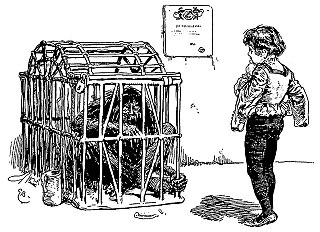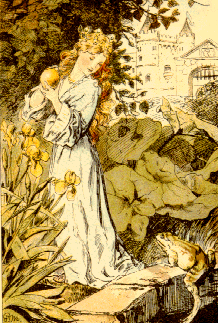
"Iron John" is a German fairy tale found in the collections of the Brothers Grimm, tale number 136, about an iron-skinned wild man and a prince. The original German title is Eisenhans, a compound of Eisen "iron" and Hans. It represents Aarne–Thompson type 502, "The wild man as a helper".

"The Frog Prince; or, Iron Henry" is a German fairy tale collected by the Brothers Grimm and published in 1812 in Grimm's Fairy Tales. Traditionally, it is the first story in their folktale collection. The tale is classified as Aarne-Thompson type 440.
Snow-White-Fire-Red (Bianca-comu-nivi-russa-comu-focu) is a Sicilian fairy tale collected by Giuseppe Pitre and translated by Thomas Frederick Crane in Italian Popular Tales.
"Thirteenth" is an Italian fairy tale originally collected by Sicilian folklorist Giuseppe Pitrè and published by Thomas Frederick Crane in Italian Popular Tales. It is Aarne-Thompson type 328, "The Boy Steals the Giant's Treasures".
Gold-Tree and Silver-Tree is a Scottish fairy tale collected by Joseph Jacobs in his Celtic Fairy Tales. It is Aarne-Thompson type 709, Snow White. Others of this type include Bella Venezia, Nourie Hadig, La petite Toute-Belle and Myrsina.

The Mermaid and the Boy is a Sámi fairy tale first collected in the mid-19th century. It tells the story of a prince unknowingly promised to a mermaid before he was born, then obtains magical powers to transform into animals later in the story.
Molly Whuppie is an English language fairy tale set in Scotland. It was first published in 'Three Folk-Tales from Old Meldrum, Aberdeenshire' in "Folklore" (6.2.1884). Rev. Walter Gregor said that the tales had been 'communicated to me by Mr. Moir, Rector of the Grammar School, Aberdeen. He had them from his mother, who kindly wrote out " Mally Whuppie " and " The Red Calf" at my request.' Anglicising the name to "Molly" from "Mally" Joseph Jacobs used this source of the story in his English Fairy Tales. A Highland version, Maol a Chliobain, was collected by John Francis Campbell in Popular Tales of the West Highlands. Jacobs noted the relationship between the two tales, and an Irish variant, "Smallhead," and concluded that the tale was Celtic in origin.
The Green Knight is a Danish fairy tale, collected by Svend Grundtvig (1824-1883) in Danish Fairy Tales (18??) and by Evald Tang Kristensen (1843-1929) in Eventyr fra Jylland (1881). Andrew Lang included a translation of Kristensen's version in The Olive Fairy Book (1907).

The Sea-Maiden is a Scottish fairy tale collected by John Francis Campbell in Popular Tales of the West Highlands, listing his informant as John Mackenzie, fisherman, near Inverary. Joseph Jacobs included it in Celtic Fairy Tales.

"The Love for the Three Oranges" or "The Three Citrons" is an Italian literary fairy tale written by Giambattista Basile in the Pentamerone. It is the concluding tale, and the one the heroine of the frame story uses to reveal that an imposter has taken her place.
Sapia Liccarda is an Italian literary fairy tale written by Giambattista Basile in his 1634 work, the Pentamerone. It is not known whether he had a specific source, either literary or oral, for this tale.
Anthousa, Xanthousa, Chrisomalousa or Anthousa the Fair with Golden Hair is a Greek fairy tale collected by Greek folklorist Georgios A. Megas in Folktales of Greece. Other variants were collected by Michalis Meraklis and Anna Angelopoulou.

The Encyclopedia of Fairy Tales is a German reference work on international Folkloristics, which runs to fifteen volumes and is acknowledged as the most comprehensive work in its field. It examines over two centuries of research into the folk narrative tradition. It was begun by Kurt Ranke in the 1960s and was continued by chief editor Rolf Wilhelm Brednich, both of the Göttingen Academy of Sciences.

Little Wildrose is a Romanian fairy tale. Andrew Lang included it in The Crimson Fairy Book.
Sindhi folktales play an important part in the culture of the Sindhi people of southern Pakistan. Pakistan's Sindh province abounds in fairy-tales and folktales that form its folklore. Some of these folktales (قصا) are particularly important for the development of higher literature in Sindhi, since they were to form the core of mystical tales of Sindh immortalized by Shah Abdul Latif Bhittai, and are generally known as Heroines of Shah.
Fabula is a multilingual academic journal on comparative folklore studies with a focus on European narratives. It publishes essays, reviews, and conference reports in German, English, and French. Its subtitle is: Zeitschrift für Erzählforschung. Journal of Folktale Studies. Revue d'Etudes sur le Conte Populaire.
Max Lüthi was a Swiss literary theorist. He is considered the founder of formalist research on folk tales.
Hans-Jörg Uther is a German literary scholar and folklorist.
In folkloristics, "The Animal as Bridegroom" refers to a group of folk and fairy tales about a human woman marrying or being betrothed to an animal. The animal is revealed to be a human prince in disguise or under a curse. Most of these tales are grouped in the international system of Aarne-Thompson-Uther Index under type ATU 425, "The Search for the Lost Husband". Some subtypes exist in the international classification as independent stories, but they sometimes don't adhere to a fixed typing.
Adventures of a Boy is the title of an Azeri folktale first collected in Russian language in the early 20th century.









